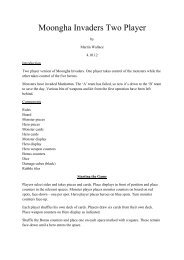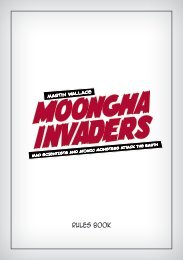A Few Acres Of Snow â 2nd Edition Rules (PDF) - Treefrog Games
A Few Acres Of Snow â 2nd Edition Rules (PDF) - Treefrog Games
A Few Acres Of Snow â 2nd Edition Rules (PDF) - Treefrog Games
Create successful ePaper yourself
Turn your PDF publications into a flip-book with our unique Google optimized e-Paper software.
If you are the defender in a siege combat and you have an<br />
advantage in military strength of one or more, then you immediately<br />
win that combat. You retain control of the location.<br />
Once a siege has ended both players retrieve their cards from the<br />
corresponding siege card space, i.e. if the British were the besiegers<br />
then each player would take their cards from the British Siege Card<br />
space. The winner places all of his cards on to his discard pile. The<br />
losing player must select one of the cards to be placed back in his<br />
empire deck or neutral empire display before placing the remainder<br />
onto his discard pile. He cannot choose to lose a location card. The<br />
French player could choose the infantry card that is part of his initial<br />
draw deck. If the loser is not able to select a card for removal then<br />
he does not do so. The attacker’s siege location marker should<br />
be retrieved.<br />
Example: In the British siege of Louisbourg the British player has<br />
managed to gain the upper hand. At the start of his turn the siege<br />
marker shows that he has an advantage of three strength points, which<br />
means that he wins the siege. The blue cube is removed and claimed<br />
by the British player. As Louisbourg has a settler symbol in it the British<br />
player must now choose whether he wishes to play a card with such a<br />
symbol to be able to place a cube of his own there. He chooses to do<br />
so and plays the New York card. He then places one of his cubes in the<br />
location. He then takes the Louisbourg location card from his location<br />
card deck and places it on his discard pile.<br />
British Siege Card space on your side of the board. This includes<br />
location cards that you play for their military strength.<br />
You can only reinforce locations that you can trace a series of<br />
connections via controlled locations from either Quebec (if you are<br />
the French player) or Boston (if you are the British player). These<br />
connections may be made by river, lake, road and sea. Indian trails<br />
do not count as connections for this purpose. You do not need to<br />
play any cards to travel along these connections.<br />
Fortification card A fortification card can be played in a siege<br />
BUT only by the defending player. When played this way it has a<br />
strength of one. Note that you cannot add a fortification disc to<br />
a location that is currently besieged.<br />
Ship symbols A card with a ship symbol has a military<br />
strength of one if used in a siege that occurs in a location<br />
that has a ship symbol next to it. If a location card has a<br />
ship symbol and a military symbol then you can only use<br />
one of those symbols, the card would not add two to your strength.<br />
You can play a card with a ship symbol as the first military card in a<br />
siege, as long as ships can be played.<br />
Military leader Playing a military leader<br />
card is a free action and adds one to your<br />
siege strength.<br />
The French player must choose one empire card to return to his empire<br />
deck from the cards in his siege space. He then returns the remaining<br />
cards to his discard pile. The British player returns all of the cards in his<br />
siege space to his discard pile.<br />
Note that the French player does not remove the Louisbourg card from<br />
those in his active deck. This card is now effectively useless.<br />
Reinforce a siege<br />
To increase your strength in a siege, whether<br />
you are the attacker or defender you can play<br />
one card that has one or more military symbols<br />
on it. You adjust the siege strength marker a<br />
number of spaces in your favour equal to the<br />
number of military symbols on the card. If there<br />
are two sieges in progress then you choose<br />
which one to use the card for.<br />
The card you play must be placed in the<br />
corresponding siege card space. E.g. If the<br />
British are the besiegers and you are the French<br />
player then you would place your card in the<br />
Raid<br />
To launch a raid you play one or more cards<br />
that state they can be used to raid. One card<br />
allows you to raid a location that is within<br />
two connections of a location that you control.<br />
Each additional eligible card played increases<br />
the range by one connection, so if you played<br />
three cards you could raid a location up to four<br />
connections away. A Priest or Indian Leader<br />
card can be played to increase the range of<br />
a raid, just as if it were another card that<br />
allowed a raid.<br />
You must pay one money for each Native Americans card that you<br />
play, not just the first one.<br />
You can only raid along connections formed by rivers, roads,<br />
lakes, or Indian trails. You can utilise any combination of these<br />
connections. Locations along the edge of the same lake are all<br />
regarded as being connected to each other. You do not play any<br />
location cards to launch a raid and you do not need to play any<br />
transport symbols.<br />
You can raid beyond a location that contains an enemy cube or<br />
disc. You cannot raid a location that has a fortification disc in it, nor<br />
can you raid beyond such a location. You cannot raid into or from a<br />
besieged location. You can raid through a besieged location if you<br />
are the besieging party and the location is not fortified. You cannot<br />
raid through a location that your opponent is laying siege to. You<br />
can raid from a location that is not in supply.<br />
Your opponent now has the opportunity to block the raid. He can<br />
do so by playing one card from his hand that states that it can block<br />
8











